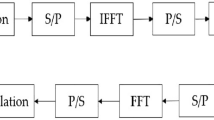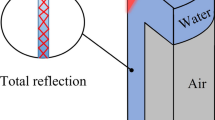Abstract
This paper investigates the light propagation through several types of water by experimental and simulation. The Zemax-ray tracing software allowed to simulate the propagation of light in water and to observe the receiver response by reproducing the real conditions of propagation. The underwater environment has been reproduced by a 1.2 m long water tube and 20 cm in diameter with a glass window fitted on one side. The use of tap water with different amounts of sand leads toward three types of water with different attenuation coefficients (0.133, 0.343, 0.580 m−1). The light transmission in the three types of water was experimentally evaluated using a doubled Nd:YAG laser with energy of 4.3 mJ and a pulse width of 20 ns. Comparisons were done between simulation and experimental results.
Similar content being viewed by others
References
Wan D Z, Chin C S. Simulation and prototype testing of a low-cost ultrasonic distance measurement device in underwater. Journal of Marine Science and Technology, 2015, 20(1): 142–154
Grelowska G, Kozaczka E, Kozaczka S, Szymczak W. Gdansk Bay sea bed sounding and classification of its results. Polish Maritime Research, 2013, 20(3): 45–50
Cho H, Gu J, Joe H, Asada A, Yu S C. Acoustic beam profile-based rapid underwater object detection for an imaging sonar. Journal of Marine Science and Technology, 2015, 20(1): 180–197
Molebny V, McManamon P, Steinvall O, Kobayashi T, Chen W. Laser radar: historical prospective—from the East to the West. Optical Engineering (Redondo Beach, Calif.), 2016, 56(3): 031220
Huang Y, Cao F, Jin W, Qiu S. Underwater pulsed laser range-gated imaging model and its effect on image degradation and restoration. Optical Engineering (Redondo Beach, Calif.), 2013, 53(6): 061608
Rumbaugh L K, Bollt E M, Jemison W D, Li Y F. A 532 nm chaotic Lidar transmitter for high resolution underwater ranging and imaging. In: Proceedings of Oceans-San Diego. San Diego: IEEE, 2013
Szulwic J, Burdziakowski P, Janowski A, Przyborski M, Tysiąc P, Wojtowicz A, Kholodkov A, Matysik K, Matysik M. Maritime laser scanning as the source for spatial data. Polish Maritime Research, 2015, 22(4): 9–14
Khairi M T M, Ibrahim S, Yunus M A M, Faramarzi M, Yusuf Z. Artificial neural network approach for predicting the water turbidity level using optical tomography. Arabian Journal for Science and Engineering, 2016, 41(9): 3369–3379
Simileanu M, Radvan R, Puscas N. Underwater LIBS investigations setup for metals’ identification. University Politehnica Of Bucharest Scientific Bulletin-Series A-Applied Mathematics And Physics, 2010, 72(4): 209–216
Wojtanowski J, Mierczyk Z, Zygmunt M. Laser remote sensing of underwater objects. In: Proceedings of SPIE Remote Sensing of the Ocean, Sea Ice, and Large Water Regions. Cardiff, Wales: SPIE, 2008
Zeng X, Xia M, Cheng Z, Li L, Chen J, Du P, Yang K. A small-size pulsed Lidar designed for obstacles detection in natural underwater environment. In: Proceedings of Applied Optics and Photonics China (AOPC2015). Beijing: International Society for Optics and Photonics, 2015
Amann MC, Bosch TM, Lescure M, Myllylae R A, Rioux M. Laser ranging: a critical review of usual techniques for distance measurement. Optical Engineering (Redondo Beach, Calif.), 2001, 40(1): 10–19
Osche G R. Optical detection theory for laser applications. In: Osche G R, ed. Optical Detection Theory for Laser Applications. New York: Wiley-VCH, 2002, 424
Jelalian A V. Laser Radar Systems. New York: Artech House: 1992
Jerlov N. Classification of sea water in terms of quanta irradiance. Journal du Conseil, 1977, 37(3): 281–287
Mobley C D. Light and Water: Radiative Transfer in Natural Waters. San Diego: Academic press: 1994
Morel A. Optical properties of pure water and pure sea water. Optical aspects of oceanography, 1974, 1: 1–24
Smith R C, Baker K S. Optical properties of the clearest natural waters (200–800 nm). Applied Optics, 1981, 20(2): 177–184
Boivin L P, Davidson W F, Storey R S, Sinclair D, Earle E D. Determination of the attenuation coefficients of visible and ultraviolet radiation in heavy water. Applied Optics, 1986, 25(6): 877–882
Sverdrup H U, Johnson M W, Fleming R H. The Oceans: Their Physics, Chemistry, and General Biology. New York: Prentice-Hall Inc., 1942, Vol. 7
Zemax Development Corporation. Zemax 13 Optical Design Program User’s Manual. 2014
Song Y, Chen Y, Xin J, Sun T. Two-dimensional beam shaping and homogenization of high power laser diode stack with rectangular waveguide. Frontiers of Optoelectronics, 2018, https://doi.org/10.1007/s12200-018-0831-z
Campazas A A, Cid M X A. Non-sequential modeling of commercial dichroic beamsplitters using Zemax. In: Proceedings of SPIE 9626, Optical Systems Design 2015: Optical Design and Engineering VI. Jena: SPIE, 2015, 96260C
Author information
Authors and Affiliations
Corresponding author
Additional information
Fatah Almabouada received the State Engineer degree (1997) and the Master degree (2013) in Electrical Engineering and is currently a Ph.D. student in Physics at Univérsité Kasdi Merbah Ouargla. At the Centre de Développement des Technologies Avancées (CDTA), he works at the Laser Systems Technologies Team (Ionized Medea and Lasers Division). His research interests include solid-state lasers and applications, optical design and optical instrumentation.
Manuel Adler Abreu has a degree in Physics and Materials Engineering (1989) and a Ph.D. degree in Physics Engineering (1996). At Faculdade de Ciências da Universidade de Lisboa Campus do Lumiar (FCUL), he works at the Laboratory of Optics, Lasers and Systems, and is coordinator of the Thematic Line of Instrumentation at the Institute of Astrophysics and Space Sciences. His research interests include optical instrumentation, sensors and optical metrology systems.
João M. P. Coelho has a degree in Physics and Materials Engineering (1992) and a Ph.D. degree in Physics Engineering (2003). At Faculdade de Ciências da Universidade de Lisboa Campus do Lumiar (FCUL), he works at the Laboratory of Optics, Lasers and Systems, and is coordinator of the Thematic Line Cancer Therapy and Drug Delivery at the Institute of Biophysics and Biomedical Engineering. His research interests include laser interaction with matter, biophysics, optical design and optical metrology. In these areas, he has published more than 90 articles in books, journals and proceedings. He has been, and is, project leader, task responsible or just team member in several international projects.
Kamal Eddine Aiadi received his B.S degree in Physics from Batna University (Algeria) and his Master degree from Bridgeport University (USA). He received his Ph.D. degree from Batna University (Algeria). Since 1987, he is a teacher at the Univérsité Kasdi Merbah Ouargla, and researcher, in LENREZA laboratory, at the same university. His research interests include optics, sensors, lasers and renewable energy.
Rights and permissions
About this article
Cite this article
Almabouada, F., Abreu, M.A., Coelho, J.M.P. et al. Experimental and simulation assessments of underwater light propagation. Front. Optoelectron. 12, 405–412 (2019). https://doi.org/10.1007/s12200-019-0865-x
Received:
Accepted:
Published:
Issue Date:
DOI: https://doi.org/10.1007/s12200-019-0865-x




